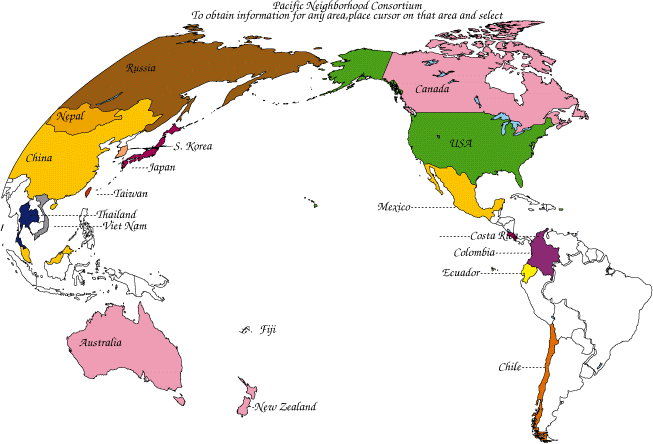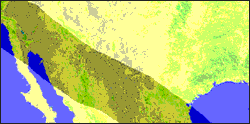
American West as Borderland
Scholars have been recently been examining the impact of the Frontier idea on American ideology. This has especially focused on Turner's thesis, whose delineation of the frontier as a "line between civilization and savagery" is certainly problematic in a pluralistic society made up of people from both sides of that "line." In recent studies of America, scholars have discussed the role of the "borderland"--the region of interaction between varied communities--in shaping the nation. Borderlands can be geographic as well as intellectual, and can be zones of interaction, cultural exchange, and contestation.
The West is part of two borderlands--the Pacific Rim and the Southwest.
The Pacific Rim
The region of land that surrounds the Pacific Ocean is called the Pacific Rim and includes more than thirty nations in Asia, Oceania, and North and South America. About 2.5 billion people live in this region, which is four-tenths of the population of the world, and the total gross domestic product in this region, which includes the two economic superpowers (the United States and Japan), accounted for 56 percent of the world gross domestic product in 1996. Now, economic growth in developing Asian nations is making the rest of the world pay more attention to this region.
The emergence of the Pacific Rim as a major economic region represents a major shift in the world's regional power distribution. In the twentieth century, economic and political power resided in the nations on or near the Atlantic Ocean—Great Britain, the United States, France, and Germany. Earlier, economic power had been concentrated in Europe. The unification of Europe as the European Union is, in part, an effort to compete with Asia and the Pacific Rim.
Additional resources
The Southwest

The borderlands between Mexico and the United States have long been a region characterized by both fascination and misunderstanding. First established after the Mexican-American War in 1848, the 2,000-mile dividing line between the two nations is today the subject of much concern for academics, journalists, businesspersons, politicians, and citizens of both nations.
North America's first frontier was a Spanish one: "The Anglo-Americans who came into Texas with Stephen F. Austin were not in the true sense pioneers; they found not a wilderness, but a society already in existence, and a foreign power in possession. Neither were traders who came across the Great Plains to traffic at Santa Fe and southward into Chihuahua. Folk of European origin were already well established and had a society ready to do business. The forefathers of not a few had been established there some years before there was a Jamestown, quite a few more than that 1620 date which saw the Pilgrims arrive, and so, too, of other proud Anglo-American centers. The few hardy souls, trappers generally, who slipped beyond the Divide and wandered southward, to Arizona, also found European men before them—not many, perhaps, save those around Tucson and Tubac...Nowhere in the Borderlands was the Anglo-American a pioneer. His frontier in these parts ran head-on into another and older one...That is part of the post-Spanish Borderlands story." -- John F. Bannon, The Spanish Borderlands Frontier, 1513-1821, 1970.
Additional Resources
Readings:
Response paper: Use your readings; focus on either the Pacific Rim or the Southwest to explain how the West is a borderland and not a frontier.